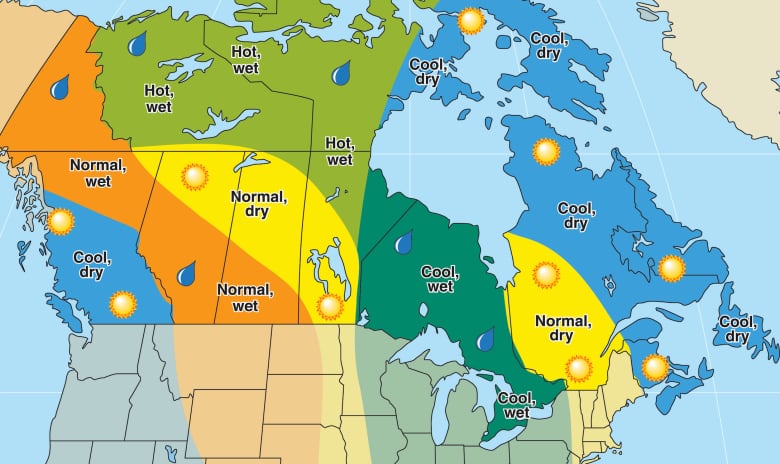What will winter be like in your part of Canada? The Old Farmer's Almanac gives us a sneak peek
What you may as well start to expect and accept, starting now.

That nip in the autumn air tells us that winter is on its way and, true to our nation's history, it will likely suck. But suck how much, where and for how long? These are the questions we ponder while watching the falling leaves. Well, if you want to stop pondering this year (and every year after that), it would be wise to consult the Old Farmer's Almanac - a storied periodical offering long-range weather forecasts, astronomy and much more. We checked in with Managing Editor Jack Burnett for the lowdown on the Old Farmer's Almanac and what to expect for Canada this coming winter.
Did we mention "Old"?
The Old Farmer's Almanac is North America's longest-running continuously published periodical and, though it was first published in 1792 by Robert B. Thomas, there were many farmer's almanacs before that. "Almanacs were kind of the Google of their day", says Burnett, containing all kinds of information, such as astronomical farming, day lengths, tidal times and even local information like stagecoach routes, polling sites and college vacation dates. If you could do the math and information gathering, it was an easy way to make money and Robert B. Thomas first sold his for around 6 cents.
While other almanacs eventually fell by the wayside, Thomas' version persisted, giving us the publication we know now, 227 years later. In 1815, as legend has it, Thomas fell ill and, in an attempt to hold the space at the printing press, the prediction of "snow and sleet" was placed into the summer forecast for 1816 — and erroneously went to press without being replaced. Thomas was a laughing stock for seemingly having made such a ludicrous prediction, that is, until the summer came around. Thanks to a volcanic eruption in the East Indies, the summer of 1816 was unseasonably cold, and Thomas' reputation was (accidentally again) saved.
The Canadian edition has been in print for 37 years, priding itself on offering the same useful information as the original, but with a premium on Canadian content and authors.
Not just weather

Though it's most commonly associated with weather, those unfamiliar with the Old Farmer's Almanac might be surprised to know the publication (along with its website) offers hundreds of pages of information covering planting practices, food recipes, history, humour, contests, folklore and astronomy. The Almanac's mandate (as it appeared in its original publication) is to be "useful, with a pleasant degree of humour".
The weather predicting process
Though Burnett says their exact method of weather prediction is "totally top secret", he concedes that it takes into account three different factors - meteorology (the science of atmospheric conditions), climatology (the general weather patterns of a region over a number of years) and solar science. Though it initially started based on anecdotal evidence, modern technology (and the availability of long-term data) has transformed the process into a series of computer algorithms that Burnett admits is "more like a recipe". The team takes the current data and trends and determine its future based on what's happened in the past under similar circumstances. Burnett estimates there's about 20,000 different factoids that go into this process. Since the in-print forecasts cover so much time, it takes about three months of review to determine how accurate the predictions were. Over its entire history, the Old Farmer's Almanac sits around an 80% accuracy for its forecasts, though the last few years have proved quite a challenge - thanks to the erratic behaviour of climate change. However, the Almanac team remains vigilant and flexible, reviewing and tweaking their process to stay on top of their game.
The forecast

True to recent form, this winter proves to be another anomaly - the entire nation will be covered in snow. Burnett cannot even recall the last time the whole country shared such similar levels of precipitation. However, there are a few exceptions regarding actual temperature. While the majority of the map will have a colder-than-normal winter, the very East Coast (primarily Newfoundland and Labrador and even up into eastern parts of Nunavut), will have more-mild-than-normal temperatures. Furthermore, southern Ontario and B.C. will share seasonably average temperatures, as the rest remain cold to very cold. Burnett also mentions cold and flurries for this year's Grey Cup.
As far as length is concerned, the majority of the winter weather will be concentrated into January and February, as per usual, but the snow will linger through most of the country until March. The Prairie provinces will have it even longer, snowing through April, though it won't be very cold. Burnett says this all adds up to "good spring skiing and good for planting, with all the moisture in the ground come spring."
Beyond winter, the spring and summer are more varied in temperature and precipitation, though not heavy on the heat. The East Coast, Ontario and B.C. will be experiencing cooler-than-normal summers, while the Northwest Territories and parts of Nunavut will actually be much warmer than they usually are. There will still be plenty of summer left to enjoy, just not as much as usual, warns Burnett, "get your lawn chairs out, but get ready to move them."
